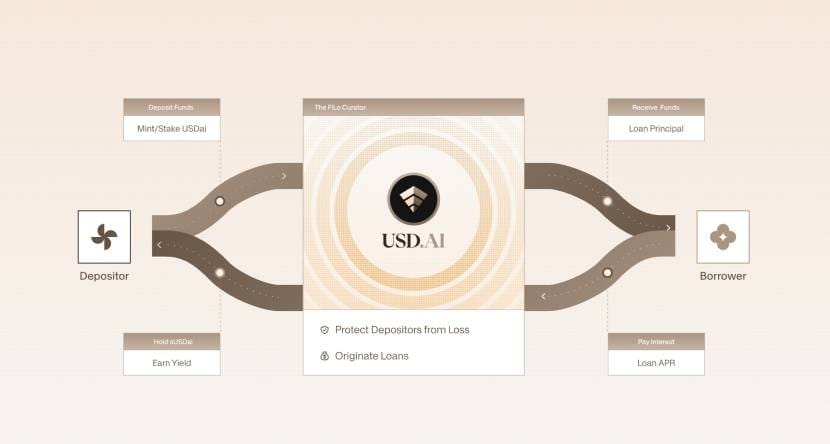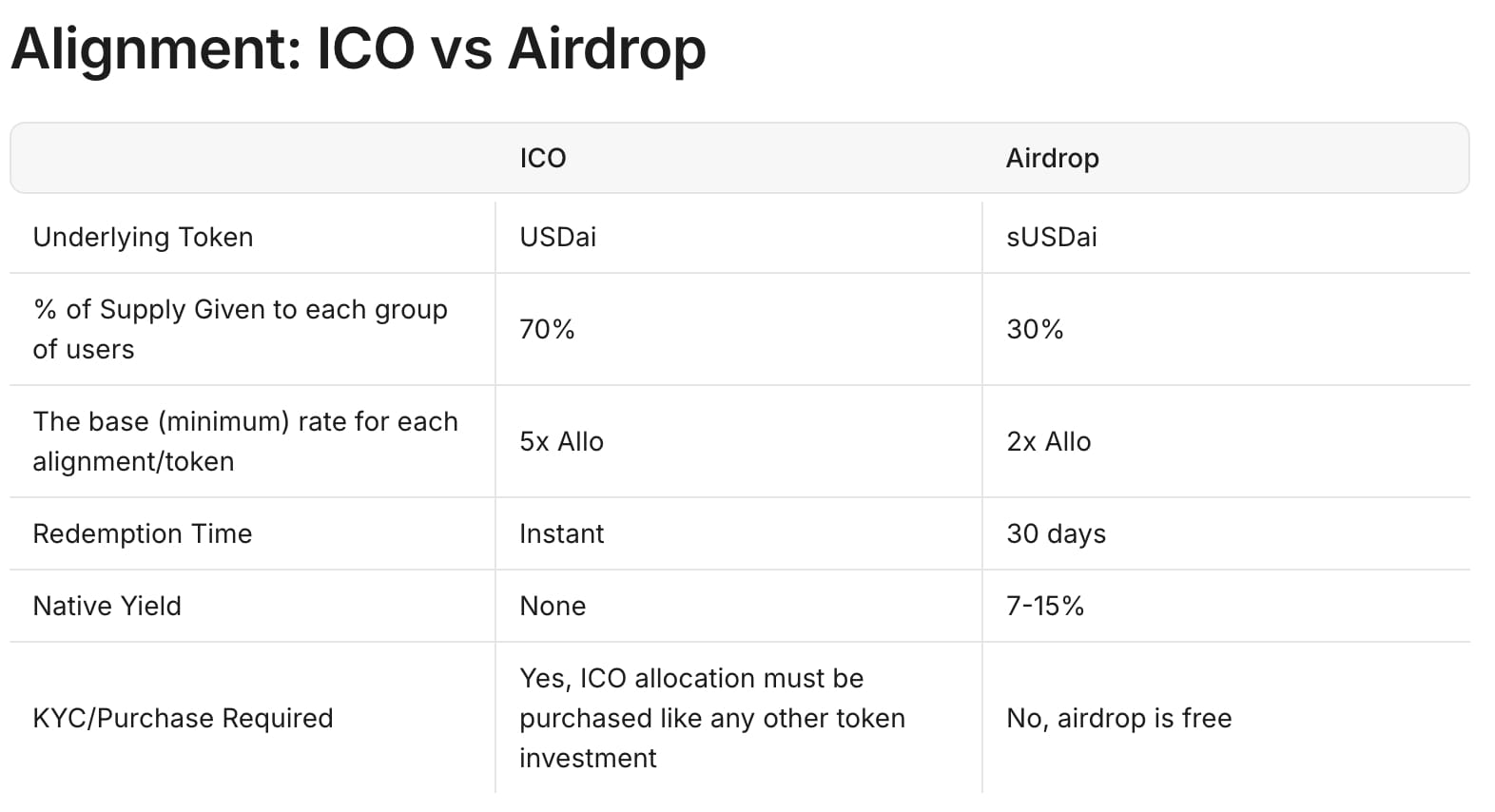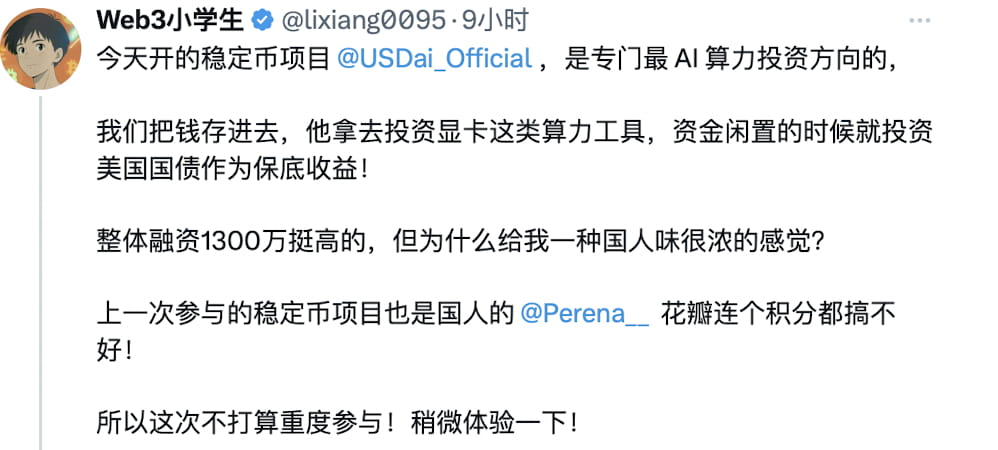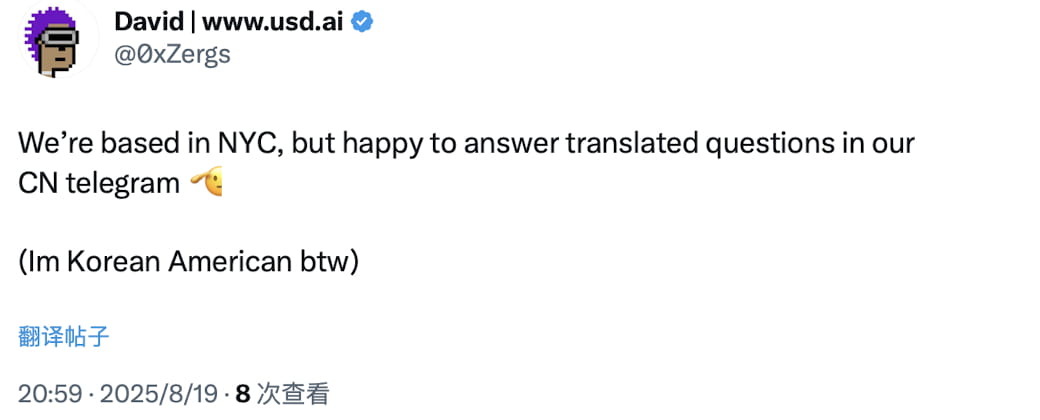Written by: Umbrella, Deep Tide TechFlow
According to Coingecko data, the current global stablecoin market capitalization has exceeded $285 billion. Major players such as Circle and Kraken are also entering the stablecoin payment chain track.
However, the vast majority of current stablecoin projects still primarily rely on traditional models such as pegging to the U.S. dollar and U.S. Treasury bonds, with overall innovation appearing somewhat lacking and generally 'lacking imagination.' In this context, a distinct challenger is breaking into the market with a fresh approach.
Recently, a unique stablecoin project USD.AI, which integrates DePIN, RWA, and AI, has sparked enthusiastic discussions in the market. It does not merely peg to the U.S. dollar but generates returns through AI hardware collateral, filling the financing gap for computational resources.

Earlier today, USD.AI officially launched and opened the deposit channel, rapidly increasing in popularity. This could bring new opportunities for the fusion of AI and stablecoins.
Project Background
According to Rootdata data, the project was established in 2024. Regarding the project team, one of the core founders of USD.AI, David Choi, is a co-founder and CEO of the well-known NFT lending platform MetaStreet and was previously an analyst at Deutsche Bank's investment banking division.
What truly brings USD.AI into the spotlight is its remarkable financing background.
On the 14th of this month, USD.AI announced the completion of a $13.4 million Series A financing led by Framework Ventures.
As an investment institution focused on DeFi and infrastructure, Framework Ventures has previously supported star projects like Uniswap and ChainLink. Its participation in leading USD.AI reflects the institution's recognition of the project's innovative value. Other investors are equally strong, including well-known crypto VC Dragonfly, Layer2 network giant Arbitrum, and the recently IPO-listed popular exchange Bullish.

This round of financing not only injects strong resources into USD.AI but also validates the appeal of stablecoin projects combining DePIN and AI to top-tier capital, significantly raising market expectations for it. After the financing information was released, the USD.AI project team seized the opportunity and officially launched on the 19th, sparking widespread discussion in the market.
Operation principles and core mechanisms
Against the backdrop of increasing demand for AI computing power, USD.AI is designed to combine stablecoin protocols with AI infrastructure financing to solve the problems that other projects in the current market have not addressed:
Small and medium-sized AI companies possess valuable GPU hardware but find it difficult to obtain operational funding through traditional channels.
The core objective of the project is to support AI companies' hardware procurement and operations through on-chain capital, filling the financing gap left by traditional finance in the new AI economy while maintaining the low-risk characteristics of stablecoins.
USD.AI revolves around a closed-loop system of 'Collateral - Mint - Invest - Yield,' combining the current popular concepts of RWA and AI, showcasing its unique innovative advantages in this wave of stablecoins.
The operation of USD.AI begins with users using stablecoins such as USDT or USDC as collateral to mint USDai stablecoin at a 1:1 ratio. USDai is supported by U.S. Treasury bonds and mainstream stablecoins to achieve a peg to the U.S. dollar price, with instant redemption capability and a certain level of liquidity, suitable for trading or providing liquidity in the DeFi ecosystem. Users can further choose to stake USDai to obtain sUSDai tokens and then participate in other DeFi projects for additional returns, achieving the effect of 'one fish, multiple eats.'
USD.AI will use the funds deposited by users for investment in two types of assets: first, providing loans to AI companies for purchasing GPUs and other hardware, generating high interest, with the current official website showing an annualized return rate of 6.96%; second, if funds are idle, they will be used to invest in U.S. Treasury bonds, providing stable foundational returns. sUSDai holders can amplify returns through DeFi protocols, with the project’s website stating a target annualized return rate of 15%-25%, while USDai holders enjoy low-risk stable returns.

The core mechanism of USD.AI includes several key components to ensure its innovation and stability:
1. Dual Token System: USDai serves as a low-risk stablecoin for users seeking stability; sUSDai targets investors seeking high returns, providing flexibility and risk exposure. This design meets the needs of users with different risk preferences while maintaining compatibility within the DeFi ecosystem.
2. Asset Tokenization and Caliber Framework: Through the CALIBER framework, USD.AI will tokenize physical assets like AI hardware into on-chain assets, ensuring transparent ownership of assets with legal enforceability through legal and technical means. The on-chain insurance mechanism further reduces default risks.
3. QEV Redemption Mechanism: To address the long-term and low liquidity of AI infrastructure assets, USD.AI has designed a QEV mechanism that manages sUSDai redemption requests through a market-driven approach, avoiding the inefficiency of first-come-first-served while ensuring fairness and stability of the protocol.
4. FiLo Curator Expansion Mechanism: This mechanism allows the protocol to massively introduce new borrowers, expand the AI infrastructure investment portfolio, and maintain user interests through structural protection and risk alignment mechanisms, ensuring diversity and sustainability of revenue sources.
In summary, the funds deposited into USD.AI will be used to loan to AI companies that require computational power from GPUs and other hardware devices to earn interest, with full transparency. If funds are idle, they will be used to purchase U.S. Treasury bonds for guaranteed returns.
The innovative mechanism of USD.AI gives it a unique competitive advantage. Compared to traditional stablecoin projects, USD.AI achieves higher returns through investments in AI infrastructure; compared to high-risk DeFi protocols, its risk isolation and insurance mechanisms significantly reduce systemic risk.
USD.AI not only injects new vitality into the stablecoin market but also provides an expandable solution for the capital demands of the AI economy, promising to become a pioneering project in the integration of stablecoins and AI infrastructure.
Participation Methods
Currently, the USD.AI project has opened user deposits and invites other users to obtain the USD.AI rewards system Allo points.
Users can obtain final token rewards through two methods: ICO and airdrop. All participants will enter with a project valuation of $30 million (corresponding to 10% of a total FDV of $300 million).
According to official tweets, minting or staking USDai will continuously generate points daily, and users can choose different strategies to determine their final ICO quota or airdrop rewards.
The Allo points activity will end when YPO (cumulative paid returns) reaches $20 million. Users choosing the ICO quota need to go through KYC, while those opting for airdrops do not need to go through KYC.
More advanced ways to earn Allo points can be learned through the introduction video in the official tweets.

In simple terms, if one wants to participate in the project ICO, holding USDai is sufficient; if one wants to participate in the airdrop, they need to stake USDai to obtain sUSDai.
Currently, purchasing USDai or sUSDai will yield qUSDai, where qUSDai serves as a deposit queue proof and will automatically convert to the corresponding token within 24 hours.
USD.AI currently has a total deposit cap of $100 million. As all purchased funds are currently in qUSDai status, the current TVL only shows the $52 million deposited during the testing phase.

Market Discussion
Current market views on the USD.AI project are polarized.
Supported users generally believe that USD.AI is a stablecoin project with unique innovations, combining the currently popular AI concepts, allowing users to enjoy AI dividends while ensuring stable returns. It provides multiple participation strategies, enabling different types of users to find suitable solutions, combining the 'stable' characteristics of stablecoins while also offering high-risk, high-reward options.

However, opposing users argue that the information currently disclosed by USD.AI indicates that its team background is likely predominantly Chinese, and the project merely stacks popular concepts without substantial innovation.

Interestingly, David, the core founder of USD.AI, just replied to this FUD tweet, identifying himself as a Korean-American and stating that the project's headquarters is located in New York, but he is very willing to answer questions from Chinese users.

The author believes that USD.AI indeed provides a different answer in the popular stablecoin track, but whether it can gain market favor and recognition still depends on whether people are willing to 'vote with their feet' to quickly fill the $100 million TVL cap.
Its success or failure will also serve as a litmus test for the market's acceptance of the emerging narrative of 'AI infrastructure + stablecoin.'


